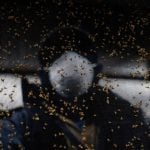A $20-per-pelt “incentive” on coyotes in Nova Scotia starting this fall is expected to put the fear of humans back in an increasingly bold population.
“The aggressive coyote situation is a serious issue in many communities, and our decision today is based on all available science and professional experience,” Agriculture Minister John MacDonell said in a release Thursday.
“These new measures are designed to change the behaviour of aggressive coyotes so they retain fear and avoid humans.”
The province’s four-part program includes training for 15 trappers to target aggressive coyotes, especially those found near settled areas.
Read Also

U.S. livestock: ‘Cattle on feed’ report supports prices
Chicago cattle futures rose as the USDA’s ‘Cattle on Feed’ report showed inventories two per cent down from a year…
The province said it will also hire a wildlife biology specialist to focus on human/wildlife contact, and will step up education programming about avoiding coyotes.
The biologist, when hired, is to develop a program to “more fully address human/wildlife conflict in Nova Scotia, develop and enhance community education programs, and conduct research on human/wildlife conflict and dealing with aggressive wildlife.”
Nova Scotia’s natural resources department, meanwhile, will offer to speak with various organizations around the province and provide printed and online information on the subject.
Starting Oct. 15, the additional $20 “pelt incentive” is to be paid on pelts sold to fur auction houses, as a way to “increase trapper participation.”
“Over-familiarity”
The incentive “is not a traditional bounty that simply provides money for dead animals, but rather it is a way to change coyote behaviour and reduces a problem wildlife population,” said MacDonell, who also oversees the natural resources ministry.
“Our wildlife biologists indicate that this trapping incentive program should help discourage over-familiarity and boldness of coyotes towards humans.”
The natural resources department’s new policy on wildlife threats calls for “immediate action” on animals that behave aggressively toward people.
Pet owners are asked to supervise their pets in areas of wildlife habitat, especially when open season begins for trapping.
Residents are also asked to contact their local Natural Resources office when coyotes or other wildlife “create a concern for human safety, property is destroyed, or a diseased or injured animal is found.”
Numerous close encounters have been reported between people and coyotes in the province in recent months. A Toronto woman died last October of injuries suffered when she was attacked by two coyotes in Cape Breton Highlands National Park.














